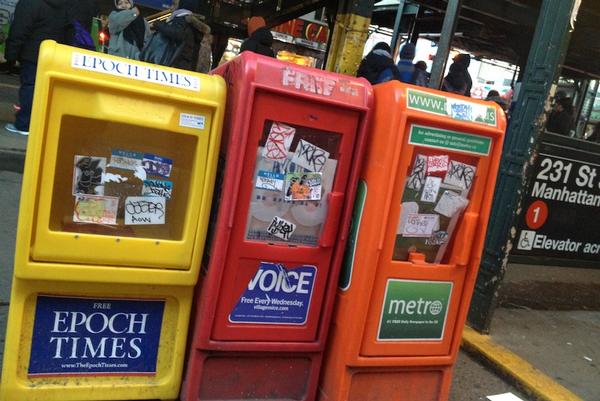
Photo by: Jordan Moss
Metro and Village Voice have a few news racks in the Bronx, like these on Broadway and W. 231st St., where the 1-train heads to Manhattan. But these, amNewYork and other city papers are barely distributed in the borough.
Hundreds of thousands of copies of Metro and amNewYork arrive on city streets every weekday morning. The free papers are at once a public service, a deliverer of advertisements, and a ton of paper. The Metropolitan Transportation Authority has complained that they create a system-wide risk for track fires, and flooding from clogged subway drains. But in the Bronx, it’s hard to find the two papers even if you try.
Their elusiveness is typical of the minimal distribution—and scanty coverage—of many big newspapers in New York when it comes to the Bronx.
For Metro, there’s a simple explanation: Fewer Bronxites have full-time jobs, wrote Wilf Maunoir, Metro’s director of marketing, in an email. “Metro is 100 percent advertising funded,” he said. “As any advertising business, the demographic matters.”
As a result, Metro distributes about 3,000 copies of its paper in the Bronx out of about 300,000 citywide, Maunoir wrote. Brooklyn gets about 26,000, Queens 51,000, and Manhattan the rest.
Maunoir wrote that there are tens of thousands of Bronx residents who pick up copies of the paper when they come to Manhattan. But there are slim pickings for those who don’t. amNewYork’s self-reported circulation is similar.
“I think it’s discrimination,” said Norma González, who lives in the Bronx and works as a home health aide in Manhattan.
“It sounds like discrimination,” said Ben Kunz, vice president of strategic planning with Mediassociates, an ad-buying agency, “but it’s a byproduct of running journalism like any other business.”
Metro and amNewYork’s business strategy jibes with what some advocates say is a broader pattern of big media’s neglect of the Bronx.
“When the first issues of The Hunts Point Express appeared, I was surprised to find how many residents felt that seeing a physical newspaper devoted to their community was a kind of validation of their neighborhood,” wrote Bernard Stein, founder and editor of the non-profit Express, in an email. “I was particularly surprised at how many young people responded to a ‘real’ paper covering them.”
Staffers of amNewYork, the Wall Street Journal, the Village Voice, the New York Post and the New York Daily News didn’t respond to our circulation questions.
New York Times spokeswoman Eileen Murphy would not say how many papers it sells in the Bronx, but suggested that stores there might not stock the paper “if there is no reader demand.”
For its part, the New York Times offers up a relatively small supply of news from the borough: a recent search of the Times’ website for “Bronx” yielded up 18,100 results over the prior seven days. “Manhattan” got 47,900, “Brooklyn” 55,700, and “Queens” 27,500.
“This is a problem with advertiser funded media,” said Jim Naureckas, the editor of Extra!, which is published by Fairness and Accuracy in Reporting (FAIR), a progressive media watchdog group. “It puts a skew in your media system towards people with more money and away from people with less money.”
The median household income in the Bronx is about $35,000, compared to about $51,000 for all five boroughs, according to census data.
The poor, meanwhile, are tuning out: people who make less than $30,000 a year read, watch, and listen to the news about 30 percent less than people who make at least $75,000, according to the Pew Research Center
The biggest disparity came on the time spent on news online, which is increasingly where people get their news. But 63 percent of Bronx households don’t even have a computer, according to a report from the city comptroller’s office earlier this year. There isn’t city data on who owns smartphones, but nationally only 43 percent of people with a household income of less than $30,000 owned one.
For some people who don’t have computers or smartphones, newspapers have retro, outsize importance. A paper like Metro is more than just news to Michael McCullough, a Mott Haven resident.
“I like it because of the offers they have. Foot doctors, laser treatments,” said McCullough, 58, who depends on disability payments.
He received acupuncture through his participation in a neuropathy study that he found in a free daily.
“I don’t usually buy newspapers because they’re a little expensive,” he said.








